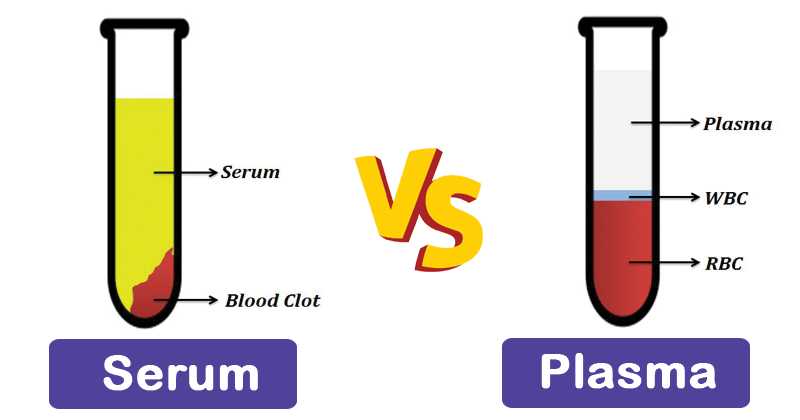
| S.N. | Characteristics | Serum | Plasma |
| 1. | Definition | The clear yellow fluid separated when blood is allowed to clot freely. | Yellowish and slight alkaline fluid, in which blood cells float. |
| 2. | Clotting factors | It is the watery fluid from blood without the clotting factors. | It is the blood fluid that contains blood-clotting agents. |
| 3. | Composition | The serum contains proteins, electrolytes, antibodies, antigens, and hormones. | It contains all suspended blood cells with proteins, salts, lipids, glucose. |
| 4. | Water content | The serum contains 90% water. | Plasma contains 92-95% of water. |
| 5. | Components | The serum contains proteins like albumin and globulins. | Plasma contains clotting factors and water. |
| 6. | Fibrinogen | Fibrinogen absent. | Fibrinogen present. |
| 7. | Cell arrangement | Cells are usually attached together by clot formation. | Cells are not attached together and suspended in plasma. |
| 8. | Method of Separation | Acquired from the process of spinning after clotting. | Acquired from the process of spinning before clotting. |
| 9. | Use of Anti-coagulant | Anticoagulant is not needed to separate the serum. | Anticoagulant is required to obtain plasma. |
| 10. | Feasibility of Separation | Separation of serum requires higher levels of expertise, expenses and is time-consuming. | Separation of plasma is relatively easy and inexpensive |
| 11. | Volume in blood | Less volume in comparison to plasma. | Consists of 55% of the total volume of blood. |
| 12. | Density | The density of serum is 1.024g/ml. | The density of plasma is 1.025g/ml. |
| 13. | Storage | The serum can be stored at 2-6 degrees centigrade for several days. | Frozen plasma can be stored for up to a year. |
| 14. | Discoloration | The serum does not discolor on standing. | Plasma tends to discolor on standing. |
| 15. | Importance | The serum is the primary source of electrolytes. | The function of the plasma is the transport of excretory metabolites and materials in the blood. It also helps in the maintenance of blood pressure and in the regulation of body temperature. |
| 16. | Associated terms | The branch of study that deals with studying serum and analyzing it for diagnostic purposes are called serology. | Plasmapheresis refers to the process of isolation of plasma from the blood using centrifugation. |
| 17. | Uses | Human serum is usually used for the purpose of diagnostic testing. Other animal seras are used as anti-venom, antitoxins, and vaccinations. They are also used in humans for therapeutic purposes. | Plasma is delivered to the patients who lack blood cells. It is also Transferred to patients who suffer from hemophilia, shocks, burns, and other clotting problems. |
Interesting Science Videos
References
- https://www.differencebetween.com/difference-between-plasma-and-vs-serum/
- https://www.bioexplorer.net/differences-between-serum-and-plasma.html/
- http://medimoon.com/2012/07/difference-between-plasma-and-serum/
- http://www.microbiologynotes.com/differences-between-serum-and-plasma/
- https://microbiologyinfo.com/difference-between-serum-and-plasma/

Excellent
Excellent